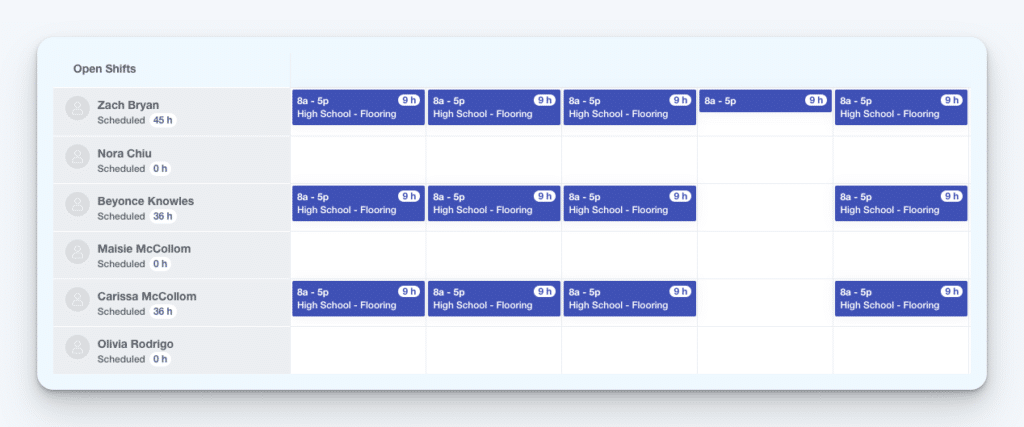How to Manage Overtime More Effectively
Learning how to manage overtime more effectively reduces labor costs and improves morale. Follow these 7 tips to get overtime under control.

Paying employees to work overtime has a significant impact on your labor costs. While there might be times when overtime is necessary — during the holidays or when trying to finish a big project by its deadline — most overtime costs are avoidable, and most businesses are best served by avoiding overtime pay.
Learning how to manage overtime more effectively delivers several benefits: it reduces your labor costs, improves work-life balance, reduces absenteeism, and improves employee morale. In this article, we’re going to look at several simple tips you can implement to reduce your reliance on overtime.
Related: Need help calculating your labor costs? Check out our free labor cost calculator.
1. Don’t unintentionally schedule your employees to work overtime

If you’re still making your employee schedules by hand on paper or in spreadsheets, you may be scheduling employees to work overtime without even realizing it. Creating schedules is time-consuming, and it can be easy to forget to calculate how many hours you’ve scheduled each employee to work when you’re just trying to hurry up and get the schedule finished.
Employee scheduling software can help you avoid scheduling employees to work overtime unintentionally. It will automatically calculate up the total number of hours you’ve scheduled an employee for over the course of a week so it’s easy to see when you’ve unintentionally scheduled an employee to work overtime.
2. Set up notifications for when an employee is nearing overtime

Even when you don’t specifically schedule an employee for overtime, they might end up working overtime hours anyway. Maybe they picked up a shift from another employee, clocked in early a few days in a row, or were late getting out of work at the end of the day. There are all common ways that unintentional overtime builds up and increases your labor costs.
To avoid this type of unintentional overtime, you can use time tracking software that alerts you when employees are nearing overtime. Set up the alert to notify you when an employee is 10 minutes away from overtime, then you can let the employee know that they need to clock out early to avoid going into overtime.
3. Set clear overtime policies
As we discussed above, it’s possible for employees to pick up shifts or add a few minutes to their hours here and there by clocking in early or clocking out late. Having overtime policies in place that let your employees know you don’t want them to work overtime can help you avoid this type of unintentional overtime.
Employees should understand when and how overtime is approved to prevent unnecessary labor costs. Require manager approval before overtime is worked, and communicate overtime policies clearly in your employee handbook.

Time tracking and scheduling software can help with this too if it has features like punch limiting and automatic clock-outs — two features included in Buddy Punch. Punch limiting prevents employees from clocking in before they’re scheduled to work, and automatic clock outs punch employees out automatically at the end of their shifts. This helps you avoid overtime caused by an extra few minutes here and there.
Learn more about Buddy Punch
- Start a free trial — no credit card required
- View pricing
- Watch a video demo
- Take an interactive product tour
- Request a personalized demo
4. Cross-train your employees
Cross-training employees can help limit overtime by making your workforce more flexible. When employees know how to perform multiple roles, they can step in when needed. This prevents work from piling up on a few people, reducing the need for overtime. If one team member is absent or overwhelmed, a cross-trained employee can take over some of their tasks.
Cross-training also improves efficiency. Employees who understand different tasks can spot issues early and solve problems faster. They can help balance workloads to make sure no one person is carrying too much responsibility. When work is spread out evenly, fewer employees need to stay late.
Additionally, cross-training helps during busy seasons. Instead of hiring temporary workers or relying on overtime, trained employees can shift between roles as needed. This saves money and keeps the team running smoothly without extra labor costs.
5. Hire more employees, or add flexible workers to your roster
If employees needing to work overtime has been a consistent problem for your business, it’s probably time to hire more employees. Your bottom line will be much better off if you hire a part-time worker to manage some of the overflow than if you pay an existing employee time-and-a-half to do the same work.
Hiring flexible workers can also help limit overtime by providing extra support when needed. Instead of relying on full-time employees to work extra hours, you can bring in temporary or contract workers to handle the workload. And if your work is too complex for a temporary worker to help, you can consider asking former employees — maybe ones who have retired — if they’d be willing to help out from time to time.
Flexible workers are especially useful during busy seasons or large projects. When demand increases, extra workers can help complete tasks without putting too much pressure on your full-time team. Once the workload returns to normal, you can adjust staffing levels accordingly without long-term commitments.
Having a pool of on-call or seasonal workers also makes it easier to cover employee absences. If a key team member is out due to illness or vacation, a flexible worker can step in.
6. Set realistic deadlines
Often, overtime hours are the result of a poorly planned project. If you don’t use historical data to determine when work can be completed, don’t take unto account issues you might encounter, and fail to add any buffer into your schedule to account for the unexpected, you may create a situation where your team has to work overtime to finish projects by their deadlines.
Before setting a due date, break the work into smaller steps and estimate how long each part will take. Consider past projects to see how much time similar tasks required. This helps create a more accurate timeline and prevents last-minute rushes.
It’s also important to build in extra time for unexpected delays. Projects rarely go exactly as planned, so allowing some flexibility prevents last-minute overtime. Finally, prioritizing tasks can also make deadlines more manageable. Focus on completing the most critical work first and schedule less urgent tasks later.
7. Encourage a healthy work-life balance
Finally, encouraging your employees to have a healthy work-life balance helps limit overtime by reducing stress and burnout. When employees are well-rested and have time for personal activities, they come to work more focused and productive. This allows them to complete tasks efficiently during regular hours.
When employees are constantly working overtime, their performance can decline. Fatigue and stress make it harder to concentrate, leading to mistakes that require extra time to fix. By promoting regular breaks and reasonable work hours, businesses can help employees stay sharp and complete tasks on time.
Encouraging balance also reduces turnover. Overworked employees are more likely to leave their jobs, forcing companies to spend time and money on hiring and training replacements. By preventing burnout, businesses can retain experienced workers and maintain productivity without relying on overtime.
Employers can support work-life balance by setting clear boundaries, discouraging after-hours work, and offering flexible schedules when possible. By making balance a priority, businesses can improve efficiency, keep employees happy, and manage overtime more effectively.




